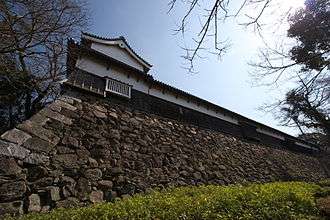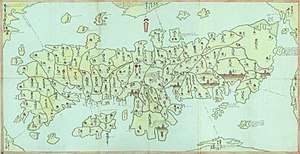Fukuoka Domain
Fukuoka Domain (福岡藩, Fukuoka han) was a Japanese domain of the Edo period. It was associated with Chikuzen Province in modern-day Fukuoka Prefecture on the island of Kyushu. The domain was also sometimes referred to as Chikuzen Domain, or as Kuroda Domain, after the ruling Kuroda family.
.png)

In the han system, Fukuoka was a political and economic abstraction based on periodic cadastral surveys and projected agricultural yields.[1] In other words, the domain was defined in terms of kokudaka, not land area.[2] This was different from the feudalism of the West. With its rating of 473,000 koku, the domain was the fifth-largest in Japan, excluding the domains held by the Tokugawa-Matsudaira dynasty.
List of daimyōs

The hereditary daimyōs were head of the clan and head of the domain.
![]()
- Nagamasa
- Tadayuki
- Mitsuyuki
- Tsunamasa
- Nobumasa
- Tsugutaka
- Haruyuki
- Harutaka
- Naritaka
- Narikiyo
- Nagahiro
- Nagatomo
- Prince Arisugawa Taruhito (briefly ruled domain as imperial governor in 1871)
Family tree





- Nagakiyo, daimyō of Nogata (1667–1720)

As Tsugutaka, the sixth daimyō, was without heirs, he adopted an heir from a branch of the Tokugawa family to continue the line:
- Tokugawa Munetada, 1st Hitotsubashi-Tokugawa family head (1721–1765)
- Tokugawa Harusada, 2nd Hitotsubashi-Tokugawa family head (1751–1827)


- Junhime (d. 1851), m.

- Rikuhime, m.

- Nagashige, 13th family head, 1st Marquess (1867–1939; family head: 1878–1939; Marquess: 1884)
- Nagamichi, 14th family head, 2nd Marquess (1889–1978; family head: 1939–1978; 2nd Marquess: 1939–1947)
- Nagahisa, 15th family head (1916–2009; family head: 1978–2009)
- Nagataka, 16th family head (b. 1952; family head: 2009–present)
- Nagahisa, 15th family head (1916–2009; family head: 1978–2009)
- Nagamichi, 14th family head, 2nd Marquess (1889–1978; family head: 1939–1978; 2nd Marquess: 1939–1947)
- Nagashige, 13th family head, 1st Marquess (1867–1939; family head: 1878–1939; Marquess: 1884)
- Rikuhime, m.
- Junhime (d. 1851), m.


- Tokugawa Harusada, 2nd Hitotsubashi-Tokugawa family head (1751–1827)
See also
- List of Han
- Abolition of the han system
References

- Mass, Jeffrey P. and William B. Hauser. (1987). The Bakufu in Japanese History, p. 150.
- Elison, George and Bardwell L. Smith (1987). Warlords, Artists, & Commoners: Japan in the Sixteenth Century, p. 18.
- Papinot, Jacques Edmond Joseph. (1906). Dictionnaire d’histoire et de géographie du Japon; Papinot, (2003). "Kuroda" at Nobiliare du Japon, pp. 25–26; retrieved 2013-4-10.
- Genealogy
External links
![]()
- (in Japanese) Fukuoka Domain on "Edo 300 HTML"